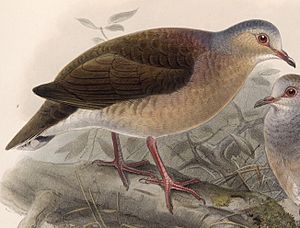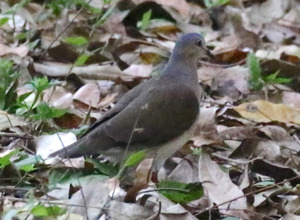Grey-headed dove facts for kids
Quick facts for kids Grey-headed dove |
|
|---|---|
 |
|
| Conservation status | |
| Scientific classification | |
| Genus: |
Leptotila
|
| Species: |
plumbeiceps
|
 |
|
The grey-headed dove (Leptotila plumbeiceps) is a beautiful bird. It is a type of large New World dove. You can find these doves from eastern Mexico all the way down to Colombia.
Contents
About the Grey-Headed Dove
How Scientists Group Them
Scientists group animals together based on how similar they are. The grey-headed dove, the grey-fronted dove, and the pallid dove are very similar. They might even be part of a "superspecies," which means they are very closely related.
Some groups of scientists, like the International Ornithological Committee (IOC), recognize two main types, or subspecies, of the grey-headed dove. These are L. p. plumbiceps and L. p. notia. Other groups include the Azuero dove as part of the grey-headed dove family.
What It Looks Like
The grey-headed dove is about 23.5 to 26 cm (9.3 to 10.2 in) long. That's about the length of a ruler! It weighs between 139 to 205 g (4.9 to 7.2 oz).
Adult male doves have a light bluish-gray color on their forehead. Their crown, neck, and upper back are a bit darker. The rest of their face is a soft pinkish-tan. Their throat and belly are white, and their chest is a pale pink. The top parts of their body are olive-brown with a reddish tint. Their tail feathers are dark olive-brown in the middle, with black and white tips on the outer ones. Their beak is black, and their legs and feet are pink.
Female doves look very similar to males. They might have a slight grayish-tan color on their chest. Young doves are more olive-colored on top. Their chest might look a bit striped. The L. p. notia subspecies is usually darker than the main type.
Where It Lives
The main type of grey-headed dove lives in eastern Mexico. You can find it south to northern Nicaragua. It also lives in parts of southern Nicaragua, northwestern Costa Rica, and the western mountains of Colombia. The L. p. notia subspecies lives on the Caribbean side of western Panama.
These doves like to live inside forests and at their edges. They live in both old, untouched forests and newer forests that have grown back. In Colombia, they seem to prefer drier types of forests.
They live at different heights above sea level. In most of Central America, they live from sea level up to 900 m (3,000 ft). In Honduras, they can be found as high as 1,500 m (4,900 ft). In Colombia, they usually live between 1,000 and 1,800 m (3,300 and 5,900 ft). They have even been seen as high as 2,600 m (8,500 ft) on Puracé, which is an active volcano!
How It Behaves
What It Eats
We don't have much information about what the grey-headed dove eats. We also don't know much about how it finds its food.
Reproduction
Scientists have found some grey-headed doves ready to breed in January. This was on the Puracé volcano. However, we don't know much else about how or when these doves have their babies.
Its Song
The grey-headed dove has a special song. It is a single, sad, and steady note. It sounds like "wooOOOoo" and gets louder and then softer.
Its Conservation Status
The IUCN is a group that checks on animals around the world. They have said that the grey-headed dove is of "Least Concern." This means it is not currently in danger of disappearing.
The dove lives in a very large area. It is quite common in most places where it lives. However, it is not as common in Colombia. Even though it's not in danger, scientists still don't know much about its life and habits.
See also
 In Spanish: Paloma montaraz cabecigrís para niños
In Spanish: Paloma montaraz cabecigrís para niños



